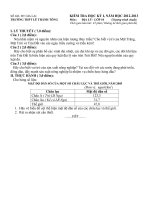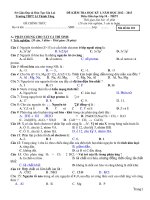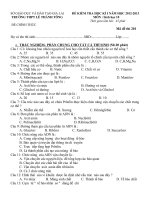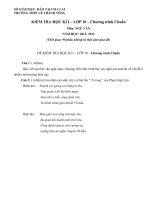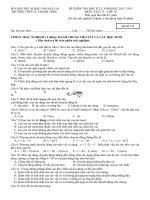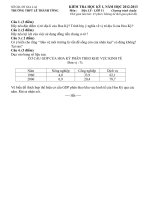starting system , LE THANH PHUC
Bạn đang xem bản rút gọn của tài liệu. Xem và tải ngay bản đầy đủ của tài liệu tại đây (1.3 MB, 39 trang )
University of Technical Education
Ho Chi Minh City
STARTING SYSTEM
Le Thanh Phuc
Faculty of Automotive Engineering
Email:
1
Introduction
The starting system is a combination of
mechanical and electrical parts that work
together to start the engine.
The starting system is designed to change
the electrical energy, which is being stored in
the battery, into mechanical energy.
To accomplish this conversion, a starter or
cranking motor is used.
2
Direct-Current Motor Principles
Magnetic lines of force flow from the
north pole to the south pole.
3
Direct-Current Motor Principles
Interaction of two magnetic fields
4
Direct-Current Motor Principles
Conductor
movement in a
magnetic field.
5
Direct-Current Motor Principles
Simple electromagnetic motor
6
Direct-Current Motor Principles
Field coil wound
around a
pole shoe.
Rotation of the
conductor is in the
direction of the
weaker field.
7
Direct-Current Motor Principles
Starter armature
Starter and
solenoid
components
8
Direct-Current Motor Principles
Lamination construction
of a typical motor
armature.
Lap winding diagram
9
Direct-Current Motor Principles
Wave-wound armature.
10
Direct-Current Motor Principles
Field coils mounted to
the inside of starter
housing
Magnetic fields in a 4-pole
starter motor.
11
Direct-Current Motor Principles
12
Direct-Current Motor Principles
13
Direct-Current Motor Principles
14
Direct-Current Motor Principles
One-way clutch
15
Direct-Current Motor Principles
Starting circuit
16
Direct-Current Motor Principles
Starting circuit
17
Characteristic of the starter motor
Speed characteristic of the starter motor: n = f (I)
e = B.l.v
B.l.π .n.D
e=
60
P.n
e = B.l.τ .
30
P.n
e = Φ.
30
ω .D
V =
2
π.D
τ=
2P
π .n
ω=
30
N
NP
Eng =
.e =
Φ. n
2a
a.60
Eng = Ce . n . Φ
n=
E ng
C e .Φ
Eng = Eo − ( ∆U ch + IRaq + IRd + IRkd )
∆U = I .rch
Eng
Eo − ∆U ch − I ∑ R
n=
=
Ceφ
Ceφ
n
Eng = Eo − ( ∆U ch + IRaq + IRd + IRkd )
Eo
I.Rd I.Ra
∆Uch
I.Rkd
Eng
Io
Inm/2
Inm
Eng
Eo − ∆U ch − I ∑ R
n=
=
Ceφ
Ceφ
n
no
φ
Eo
n
Io
Inm/2
Inm
Small load:
φ ≅ KφI
E0 − ∆U ch − I ∑ R
n≈
Ce .Kφ .I
a1
n=
I − a2
E 0 − ∆U ch
a1 =
C e .K φ
∑R
a2 =
C e .K φ


